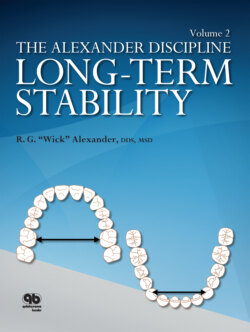Читать книгу The 20 Principles of the Alexander Discipline, Volume 2 - R.G. "Wick" Alexander - Страница 8
Author’s Note
ОглавлениеThe reality is that not every patient treated orthodontically can have long-term stability without retention. Some clever person once said that “rules are made to be broken.” In this book, a great effort has been made to identify certain facts that affect the stability of orthodontic treatment. We must realize that in dealing with individual human beings, specific circumstances may prevent us from reaching our goals.
For example, it may be that for stability’s sake teeth should be extracted, but extraction might create an unattractive soft tissue profile. Generally speaking, if I have to choose between esthetics and stability, I choose esthetics. Luckily, this situation seldom occurs.
In a particular case, because the anterior occlusion is a Division 2, the mandibular incisors are excessively lingually uprighted. After improving the torque in the maxillary anterior teeth, the mandibular anterior teeth can and should be advanced beyond the “3-degree rule.” A more normal interincisal angle can be created that is definitely more functional. However, is it stable? My answer is a restricted yes. If the mandibular arch is properly leveled, little overbite relapse should occur. Controlling intercanine width, spreading the incisor roots, and interproximal reduction all play a large part in stability success.
Many years ago at a Texas Tweed meeting, my brother Moody was grading a case that was treated with the extraction of four first premolars. In discussing this with the clinician, Moody observed the concave profile that had resulted. The clinician agreed with the analysis, but very defiantly said, “But I satisfied the triangle,” meaning the Tweed Triangle diagnosis.
Today, in diagnosing borderline extraction cases, the decision depends on appearance rather than stability. Borderline cases will be treated with nonextraction by the vast majority of orthodontists, although the teeth will be moved into unstable positions. So, this brings forth a significant question: Should the patient and parent be told that the teeth are being moved into unstable positions?
At the annual 2011 AAO meeting in Chicago, I had the privilege of being on the program. With a theme of “Finishing, Retention and Stability,” I chose to entitle my presentation “It’s Time to Stand Up for Stability.” The material I presented is found within the pages of this book. In this small way, I am standing up for stability! May my thoughts and suggestions help you treat your future patients with long-term stability as a treatment goal.
